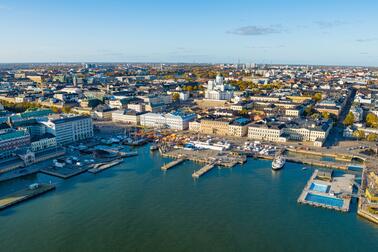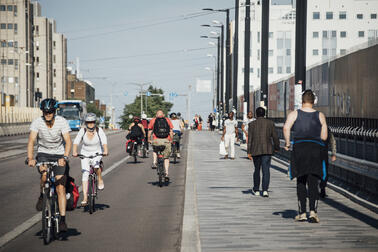
The third event in the international Sustainable Cities Discussion Forum series was held on 26 May 2023 in Helsinki. Co-hosted by the City of Helsinki and the United Nations University World Institute for Development Economics Research (UNU-WIDER), the series looked at the world’s progress towards the Sustainable Development Goals, a set of 17 targets that close to 200 UN member countries pledged to achieve by the year 2030.
The discussion forum was opened by Helsinki Mayor Juhana Vartiainen and Kunal Sen, the Director of UNU-WIDER, a UN agency based in Helsinki that provides economic analysis and policy advice on sustainable and equitable development.


Helsinki was the first city in Europe and the second city in the world to commit to voluntarily reporting its progress towards the Sustainable Development Goals (SDGs).
The first event in the Sustainable Cities Discussion Forum, featuring internationally distinguished keynote speakers and expert panels, was held in May 2022 and focused on SDG8: Decent work and economic growth. The second event, arranged in October 2022, zeroed in on SDG4: Quality Education. The third event in the series last week discussed SDG13: Climate action.
Local measures increasingly taking centre stage
The keynote speaker of the third event in the series was principal researcher for the UK branch of the International Institute for Environment and Development Aditya Bahadur. He mentioned during his address that before his departure to attend the event, the temperature in his native country of India had risen to 47 degrees Celsius.
“Once again, many elderly and sick people will die from the heat,” he said.
Bahadur reported that research shows that the probability of large-scale disasters has increased, and this requires a global response that is able to adequately prepare for a number of different sizeable and simultaneous threats. Violent cyclones have, for example, become more common, threatening coastal regions around the globe.

Heat waves are likewise no longer just a scourge of the Global South. Bahadur recalled news from last summer about extreme temperatures in the US and the resulting problems they posed for guaranteeing water supply.
He warned that the “butterfly effect”, whereby a small change taking place on the other side of the globe can result in large differences elsewhere, is not just a theory, but the truth by which we are now living.
Bahadur is especially concerned about the people living in the slums of the world, who may be uninformed and certainly don’t have the money to adapt to their changing circumstances.
His keynote at Helsinki City Hall drew attention to some of the solutions that are currently available.
First and foremost, scientific knowledge must be both disseminated and actively utilised in our daily lives. Functional shared platforms that enable the free exchange of information are integral to this effort.
The challenges confronting us must be made visible so they become known to everyone, and they must be considered in every facet of our decision-making. We know that, for example, water shortage is a problem, but how can we tackle it on a local level in light of the unique circumstances defining the area?
Artificial intelligence can also be of assistance in our decision-making, but according to Bahadur, it is no silver bullet when it comes to combating climate threats. It can however be a big help when scaling the determined best solutions cost-effectively.
He gave an example of how stifling heat is linked to our built environment, which is often characterised by large surfaces of asphalt and glass. The US is experimenting with a smartphone application that collects temperature variances and pinpoints the hottest areas. Bahadur explained that this information can help local officials better prepare for heatwaves and proactively help people who may be vulnerable.
The event’s keynote speaker also made a case for a universal commitment to taking action. He said it is not enough that only some residents participate in mitigating efforts, as people who are most affected by climate change are also needed on the front lines. Under-resourced slumdwellers living in flood areas must be included as equal actors in our climate solution efforts.
Bahadur shared an example from the pandemic with the audience: He said that in Indian slum areas, COVID-19 spread like wildfire. Officials enlisted volunteers from the area before going from house to house to tell residents about the situation. This meant that they were able to gather more detailed information about the rate of infection and target their informational outreach, which slowed the the disease’s contagion.
He also highlighted the importance of flexible and innovative financing. Climate change mitigation and adaptation costs money, and our current financing mechanisms are too slow. Money is needed, for example, for new energy systems and improving infrastructure in general. Our existing infrastructure also needs to be strengthened in order to prepare for disasters, he said.
In his opinion, the financial systems required now must be designed to work locally and more decision-making power must be extended to residents. There is already proof of several regional successes in making cost-effective decisions.
He said a fundamental problem lingers, however: reducing consumption despite population growth. People need to work, but our work should be shaped so it produces a new kind of growth and contributes to a sustainable economy.
The world needs new innovations, but now we must first come up with innovative ways to find them, Bahadur stressed.
Educating people about the green transition
US Agency for International Development (USAID) specialist Edwin Moses Sitati spoke about the situation in East Africa as a panellist at the event. He pointed out how the rapid rise in population is testing the resilience of the world’s cities. For example, Nairobi now has over 5 million inhabitants, but in a few years this number will shoot to over 8 million. The population is growing in slum areas in particular, where sanitation and waste systems are either poor or non-existent.

He explained how efforts are being made in USAID programmes to improve the collection of waste and transform it into fertilizers.
“We are searching for scalable solutions that we could then spread to urban areas,” he said.
Sitati also emphasized the importance of teaching younger generations in Africa about the importance of the green transition.
At the same time, however, he said the need for continuous lifelong learning applies to everyone. We know, for example, that the green transition requires the manufacture of a lot of batteries, which in turn requires a massive amount of mined metals. How can we extract the required amount in a sustainable way? Humanity must be capable of constant innovation and flexibility, Sitati said.
More concrete action, less greenwashing
Another panellist, Tuuli Kaskinen, reminded the event participants that much more work is being done to combat climate change and its impacts than was expected even 15 years ago. Even so, she says, we still find ourselves far from our goals.

Kaskinen is the CEO of the Climate Leadership Coalition, Europe's largest non-profit climate business network. She pointed out that there are no easy solutions, as seen in the current heated debate about Helsinki’s cycling lanes. People have objections, even though they are aware of the overall need to reduce emissions-producing traffic and invest in more sustainable transport options.
“The trick is to come up with solutions that the public can get behind,” she said.
Everyone knows about the drastic impacts of climate change, especially in the Global South. What is needed are rapid, cost-effective solutions that are in balance with consumer wishes, Kaskinen commented.
Big questions still need to be resolved in terms of economic policy as well. She pointed out how now is not the time to be at odds, but to come together to save the planet.
When asked about her work with companies working for profit, Kaskinen responded that in her experience, there is less and less greenwashing in the private sector, and more concrete work towards true sustainable development.
Zeroing in on largest emission sources
The event’s panel discussion also called attention to the decisive role of cities in mitigating and adapting to the climate crisis.
Iina Oilinki, project director of the City of Helsinki’s Climate Unit, pointed out that the City of Helsinki has strength and power in that it owns 60 per cent of Helsinki's surface area and 20 per cent of its buildings.
“We have a big responsibility to also get things done,” she said.
She explained how the Carbon Neutral Helsinki Action Plan has set out ways to get the city’s biggest emission sources under control. Among other things, the city is encouraging local industry and businesses to innovate freely. For example, the city does not specify which materials should be used in construction, but instead devotes its attention to life cycles and total emissions.

In Oiling's opinion, the argument that Finland's – or even Helsinki's – climate work is inconsequential if China’s emissions are left unchecked is ridiculous. Western countries were the main source of emissions for decades, she said, and now we happen to rely on Chinese production. Everyone has to accept their responsibility for dealing with the ramifications of world trade.
“We all share the planet. There’s no sense wasting time thinking about what others may or may not be doing. We must focus on what we can do ourselves,” she said.
Less talk, more action
The City of Helsinki’s Senior Sustainability Advisor Mia Malin rounded out the event with a short presentation of the city’s most recent Voluntary Local Review, which was published just a few days before the event.
The report was the third of its kind, in which the city’s efforts towards ecological, social and economic sustainability were assessed, but this time the theme of cultural sustainability was also added to the mix.
“Helsinki is a sustainability pioneer in many areas. But if we want to achieve our goals, we must succeed in transferring this sustainability ethic to land use, education, international collaboration and university cooperation as well,” she said.

Malin pointed out that the city organization needs to work to remove silos in its operations and better promote cross-cutting activities that are prioritized as an essential part of the city's core processes.
“It is necessary now to move beyond simply setting goals and take concrete action. Work to change attitudes and operating cultures is also key,” she said.
Mayor Vartiainen commented that it is important to monitor progress towards the active implementation of the UN goals, as well as gather for joint discussion events such as the event in question.
“All 17 goals are important, but climate action is paramount. If we don’t act quickly, we may not be able to save our planet,” he said.
The mayor highlighted Helsinki’s determined work towards doing its part to fulfil the SDGs. He highlighted one extremely tangible municipal accomplishment: This spring, the city shut down its Hanasaari coal-fired power plant, cutting 20 per cent of the city's total emissions with one blow.
Vartiainen noted that climate decisions are not always easy. Cities the world over are now the de facto watchdogs of local climate work, and some of their measures have not inspired enthusiasm. Yet the cities must pursue these improvements all the same.
UNU-WIDER Director Kunal Sen confirmed Mayor Vartiainen's message: Everyone is waiting for decisive measures from our cities.
The third event in the Sustainable Cities Discussion Forum series was organized by the City of Helsinki and the WIDER Institute of the UN University in cooperation with the Sustainability Science Days, a joint event arranged by Aalto University and the Institute of Sustainability Science of the University of Helsinki (HELSUS).
Text: Kirsi Riipinen
Photos: Ilkka Ranta-aho


